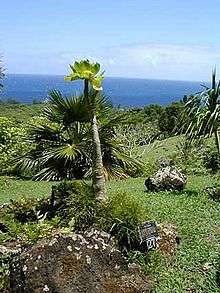Limahuli Garden and Preserve
The Limahuli Garden and Preserve (17 acres or 6.9 ha of garden, 985 acres or 399 ha of preserve) is a botanical garden and nature preserve on the north shore of Kauaʻi island, Hawaiʻi. It is one of the five gardens of the non-profit National Tropical Botanical Garden.
Description
Limahuli lies within a tropical valley covering three distinct ecological zones. It is inland from the Haʻena State Park and Keʻe beach off of Route 560 (near its western end) at 22°13′13″N 159°34′33″W / 22.22028°N 159.57583°WCoordinates: 22°13′13″N 159°34′33″W / 22.22028°N 159.57583°W. The Makana Mountain ridge looms behind, and the Limahuli Stream includes an 800-foot (240 m) waterfall[1] on its descent from the valley's high end at 3,330 feet (1,010 m) to sea level just below the garden.[2] This area is sometimes known as Bali Ha'i, a name used in the 1958 film South Pacific which was filmed on location in the area.[3] The name comes from lima huli which means "turned hand" in the Hawaiian language.[4]
The garden contains a wide range of native and Polynesian-introduced plants, including kukui (Aleurites moluccana), banana, breadfruit, alula (Brighamia insignis), Paper Mulberry (Broussonetia papyrifera), papala (Charpentiera elliptica), kī (Cordyline fruticosa), turmeric (Curcuma domestica), hāhā (Cyanea hardyi), lama (Diospyros sandwicensis), vegetable fern (Diplazium esculentum), ginger, hau kuahiwi (Hibiscadelphus distans), hibiscus including kokiʻo keʻokeʻo (Hibiscus waimeae), kava, koa (Acacia koa), nehe (Lipochaeta succulenta), ʻōhiʻa lehua (Metrosideros polymorpha), pokulakalaka (Munroidendron racemosum), kului (Nototrichium divaricatum), hala (Pandanus tectorius), pāpala kēpau (Pisonia wagneriana), plumeria, loʻulu (Pritchardia limahuliensis), sugarcane, taro, and iliau (Wilkesia gymnoxiphium). It also contains taro terraces (loʻi kalo) that date back to early Polynesian arrivals on the island.[5]
In 1997 Limahuli Garden was selected by the American Horticultural Society as the best natural botanical garden in the United States. In 2007, it received the top "Keep It Hawaiʻi" award from the Hawaiʻi Tourism Authority for its support of the Hawaiian culture, protection and development of Hawaiian knowledge by preservation of natural resources through research, hands-on work, and educational opportunities.
Limahuli Garden is open to visitors. An admission fee is charged. The preserve is not open to the public.[6] The preserve was established with 13 acres (5.3 ha) donated by Juliet Rice Wichman (1901–1987) in 1967 and extended by her grandson Charles "Chipper" Rice Wichman, who were descended from businessman William Hyde Rice and missionary William Harrison Rice.[7]
See also
- National Tropical Botanical Garden
- McBryde Garden
- Allerton Garden
- Kahanu Garden
- The Kampong
- List of botanical gardens in the United States
References
- ↑ U.S. Geological Survey Geographic Names Information System: Limahuli Falls
- ↑ U.S. Geological Survey Geographic Names Information System: Limahuli Stream
- ↑ Jeanne Cooper (March 27, 2009). "'Bali Hai' still calling visitors to Hawaii". San Francisco Chronicle. Retrieved September 23, 2010.
- ↑ Mary Kawena Pukui, Samuel Hoyt Elbert and Esther T. Mookini (2004). "lookup of Limahuli ". in Place Names of Hawai'i. Ulukau, the Hawaiian Electronic Library, University of Hawaii Press. Retrieved September 23, 2010.
- ↑ Limahuli Garden (brochure), by Nancy Merrill, Anna Stone, and Evelyn de Buhr, Limahuli Garden.
- ↑ "Limahuli Garden Tours". official web site. Limahuli Garden and Preserve. Retrieved September 23, 2010.
- ↑ "Limahuli Valley, a Living Legacy". Hawaii Stream Research Center web site. University of Hawaii. Retrieved September 23, 2010.
External links
| Wikimedia Commons has media related to Limahuli Garden and Preserve. |
